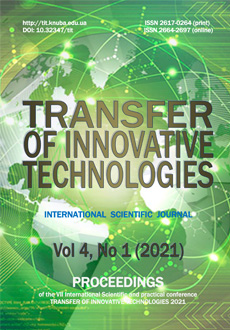Piezoelectric devices for energy harvesting in building structures
DOI:
https://doi.org/10.32347/tit2141.0102Keywords:
energy harvesting, piezoceramic sensor, transduction of energy, accumulating of energy, autonomous devices, resonance and off-resonance modesAbstract
Devices that convert vibration energy into electricity and are capable of its accumulation (energy harvesting) are very promising both in mechanical engineering (damping oscillations with the conversion of excess energy into electricity) and in electronics and the environment (systems for energy storage and replenishment). That systems convert extra motion of engineering devises into electrical energy used for their autonomous operation or for power supply of other devices [1]. Another application is portable electronics, where energy storage devices can power or charge mobile phones or other devices. When energy sources are limited, energy harvesting plays an important role in the environment.
Energy harvesting as a separate direction began to develop in the 1990s. Human, bicycle, water flow, low-frequency oscillations in mechanisms, etc. can be used as sources of mechanical energy for the piezoelectric transducer. Usually, due to steady oscillations, piezoelectric elements produce alternating electric current, showing the greatest efficiency at resonant frequencies. Most piezoelectric power sources produce power of the order of milliwatts, which is small enough for system use but sufficient for portable devices. Piezoelectric systems can convert the movement of the human body, such as the movement of legs and arms, shocks and blood pressure to obtain energy from implanted or portable sensors. Piezoelectric elements are built into running and walking roads, shoes, pavement, etc. One of the priority areas of research is the development of autonomous wireless sensors that receive energy from the measured signal, or use other ways to obtain mechanical energy. Their use becomes relevant in atypical tasks - measuring oscillations in hard-to-reach places of rotating mechanisms, seismic sensors and so on. Smart roads can play an important role in electricity generation. The incorporation of piezoelectric material into the road can convert the pressure exerted by moving cars into voltage and current.
References
Dongna Shen (2009). Piezoelectric energy harvesting devices for low-frequency vibration applications. Dissertation for the Degree of Doctor of Philosophy. Auburn, Alabama.
N. X. Yan, A. A. Basari and N. A. A. Nawir (2018) Piezoelectric ceramic for energy harvesting system: a review. ARPN Journal of Engineering and Applied Sciences, 13 (22), 8755-8775.
В.П. Матвеенко, Е.П, Клигман, М.А. Юр-лов, Н.А, Юрлова (2012). Моделирование и оптимизация динамических характери-стик smart-структур с пьезоматериалами. Физическая мезомеханика. 15 (1), 75-85.
https://www.americanpiezo.com/blog/ piezoelectric-energy-harvesting
N. Sezer, M. Koç (2021). A comprehensive review on the state-of-the-art of piezoelectric energy harvesting. Nano Energy, 80, 105567.
Grigoryeva, L.O. (2020) Transient responses in Piezoceramic Multilayer Actuators Taking into Account External Viscoelastic Layers. Опір матеріалів і теорія споруд. Strength of Materials and Theory of Structures. 105, 255-266.
Григор’єва Л. О., Безверхий О. І. (2020) Резонансні коливання п’єзокерамічних циліндрів з врахуванням дисипації енергії. Проблеми обчислювальної механіки та міцності конструкцій, 31, 44-54.
Downloads
Published
How to Cite
Issue
Section
License

This work is licensed under a Creative Commons Attribution-NonCommercial-NoDerivatives 4.0 International License.
Our journal abides by the CREATIVE COMMONS copyright rights and permissions for open access journals.
Authors, who are published in this journal, agree to the following conditions:
1. The authors reserve the right to authorship of the work and pass the first publication right of this work to the journal under the terms of a Creative Commons Attribution License, which allows others to freely distribute the published research with the obligatory reference to the authors of the original work and the first publication of the work in this journal.
2. The authors have the right to conclude separate supplement agreements that relate to non-exclusive work distribution in the form in which it has been published by the journal (for example, to upload the work to the online storage of the journal or publish it as part of a monograph), provided that the reference to the first publication of the work in this journal is included.




